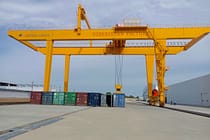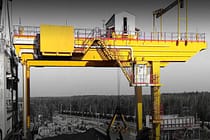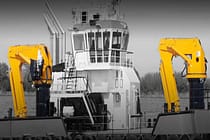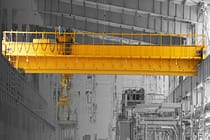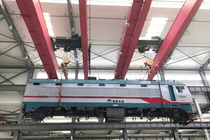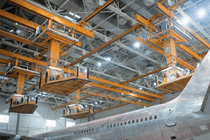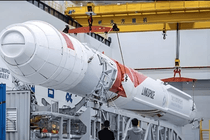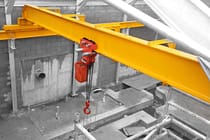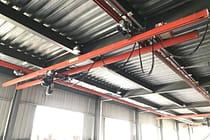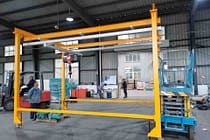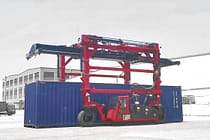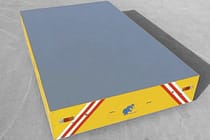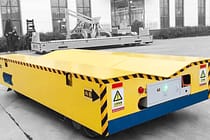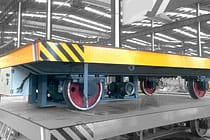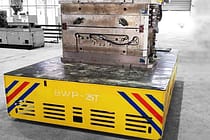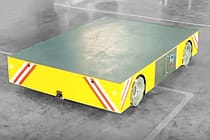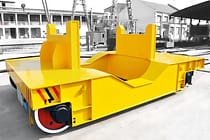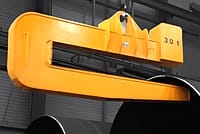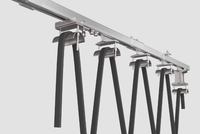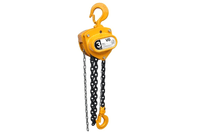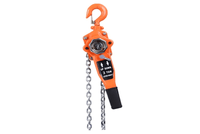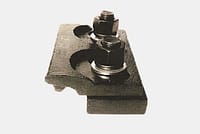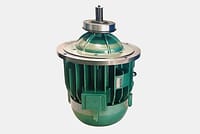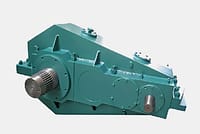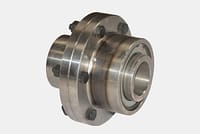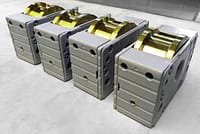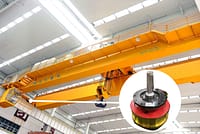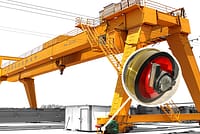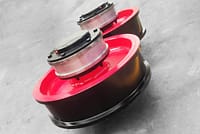วิธีการสร้างเครนเหนือศีรษะ?
คุณกำลังมองหาวิธีที่จะส่งเสริมธุรกิจการผลิตหรือการก่อสร้างของคุณอยู่หรือไม่ การสร้างเครนเหนือศีรษะของคุณเองอาจช่วยเปลี่ยนแปลงทั้งในแง่ของผลผลิตและประสิทธิภาพ อย่างไรก็ตาม อาจดูเหมือนเป็นงานที่น่ากลัวหากคุณไม่มีข้อมูลที่ถูกต้อง ในบทความนี้ เราจะให้คำแนะนำที่ครอบคลุมเกี่ยวกับวิธีการสร้างเครนเหนือศีรษะตั้งแต่ต้น
ทำความเข้าใจเกี่ยวกับเครนเหนือศีรษะ
ก่อนที่จะลงรายละเอียดเกี่ยวกับการสร้างเครน EOT เราควรทำความเข้าใจก่อนว่าเครนเหนือศีรษะคืออะไรและทำงานอย่างไร เครนเหนือศีรษะเป็นอุปกรณ์ยกชนิดหนึ่งที่ประกอบด้วยคานแนวนอนที่เรียกว่าสะพาน ซึ่งรองรับด้วยรถบรรทุกสองคันที่ปลายสะพาน สะพานจะเคลื่อนที่ไปตามรันเวย์ ทำให้เครนสามารถหยิบและเคลื่อนย้ายของหนักได้

ส่วนประกอบหลักของเครนเหนือศีรษะ
มีส่วนประกอบหลายอย่างที่ประกอบกันเป็นเครนเหนือศีรษะ เหล่านี้รวมถึง:
สะพาน: สะพานเป็นคานหลักในแนวราบที่พาดตามความกว้างของอาคาร โดยทั่วไปทำจากเหล็กและรองรับด้วยรถบรรทุกสองด้าน สะพานเคลื่อนที่ไปตามทางวิ่ง ทำให้รอกสามารถยกและเคลื่อนย้ายของหนักได้ บริดจ์มีหลายขนาดและหลายขนาดขึ้นอยู่กับการใช้งานเฉพาะและความสามารถในการรับน้ำหนักที่ต้องการ
รันเวย์:รันเวย์คือเส้นทางที่สะพานวิ่งผ่าน โดยปกติจะติดอยู่กับเพดานหรือผนังของอาคาร การตรวจสอบให้แน่ใจว่ารันเวย์ได้รับการติดตั้งอย่างถูกต้องและได้ระดับเป็นสิ่งสำคัญต่อการทำงานของเครนสะพานอย่างปลอดภัยและมีประสิทธิภาพ รันเวย์อาจทำจากเหล็ก คอนกรีต หรือวัสดุอื่นๆ ขึ้นอยู่กับข้อกำหนดของโครงการ
ท้ายรถบรรทุก: รถบรรทุกท้ายเป็นโครงล้อที่รองรับสะพานและช่วยให้เคลื่อนไปตามทางวิ่งได้ ประกอบด้วยล้อ เพลา และตลับลูกปืน และโดยทั่วไปขับเคลื่อนด้วยมอเตอร์ไฟฟ้า รถบรรทุกท้ายสามารถมีหลายขนาดและการกำหนดค่าขึ้นอยู่กับน้ำหนักและขนาดของสะพานรวมถึงสภาพแวดล้อมที่จะใช้งาน
รอก: รอกเป็นส่วนประกอบที่สำคัญของระบบเครน EOT ซึ่งมีหน้าที่ในการยกและเคลื่อนย้ายน้ำหนักบรรทุก รอกยึดติดกับสะพานและใช้ลวดสลิงหรือโซ่เพื่อยกน้ำหนักบรรทุก การเลือกรอกขึ้นอยู่กับปัจจัยต่างๆ เช่น ความสามารถในการรับน้ำหนักและความต้องการใช้งาน
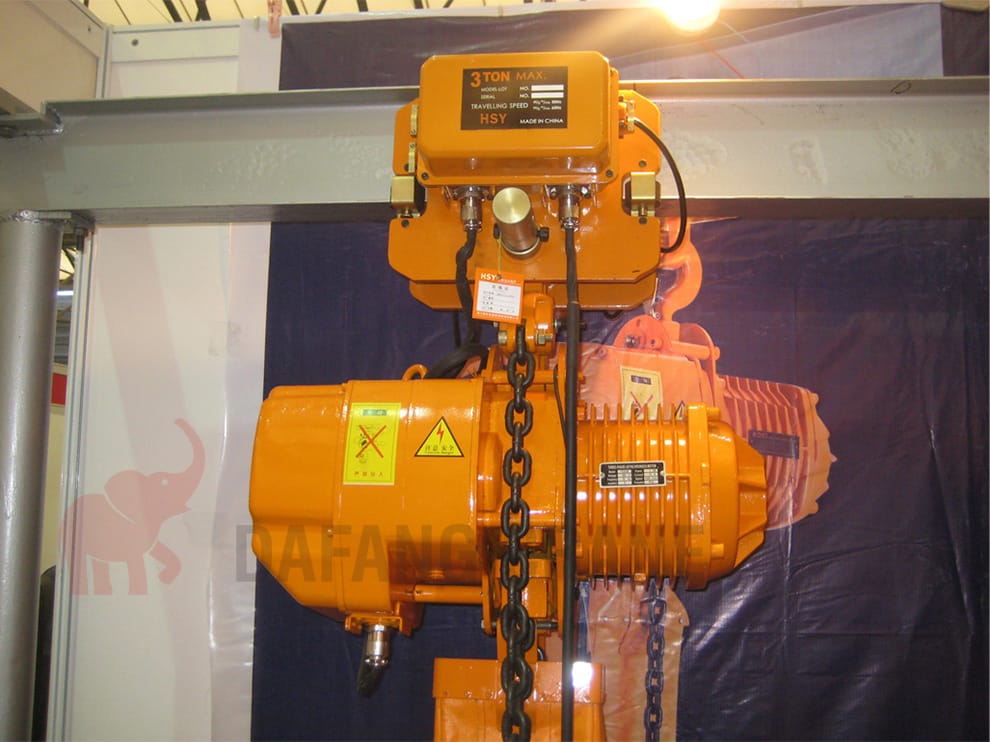
การควบคุม:ส่วนควบคุม ได้แก่ ปุ่มและสวิตช์ที่ใช้ควบคุมเครน โดยทั่วไปจะติดตั้งอยู่ในห้องโดยสารหรือห้องแขวนที่ห้อยลงมาจากเครน ผู้ควบคุมจะใช้ส่วนควบคุมเพื่อเคลื่อนย้ายสะพาน ยกและลดระดับรอก และควบคุมความเร็วของเครน การใช้ส่วนควบคุมที่ถูกต้องถือเป็นสิ่งสำคัญเพื่อให้แน่ใจว่าเครนเหนือศีรษะจะทำงานได้อย่างปลอดภัยและมีประสิทธิภาพ

การออกแบบเครนเหนือศีรษะของคุณก่อนสร้าง
การออกแบบเครนเหนือศีรษะของคุณต้องมีการวางแผนอย่างรอบคอบและใส่ใจในรายละเอียด นี่คือขั้นตอนที่เกี่ยวข้อง:
- กำหนดความจุในการโหลด
ปัจจัยที่สำคัญที่สุดอย่างหนึ่งในการออกแบบเครน EOT ก็คือการกำหนดความสามารถในการรับน้ำหนัก ซึ่งหมายถึงน้ำหนักสูงสุดที่เครนจะต้องยก ซึ่งจะส่งผลต่อการออกแบบและการก่อสร้างระบบทั้งหมด หากต้องการกำหนดความสามารถในการรับน้ำหนักได้อย่างแม่นยำ จำเป็นต้องพิจารณาปัจจัยต่างๆ เช่น น้ำหนักของวัสดุที่จะยก ระยะทางที่ต้องขนย้าย และน้ำหนักเพิ่มเติมจากอุปกรณ์ยกหรืออุปกรณ์เสริม - เลือกรอกของคุณ
เมื่อคุณกำหนดความสามารถในการรับน้ำหนักได้แล้ว ขั้นตอนต่อไปคือการเลือกรอกที่เหมาะสมกับความต้องการของคุณ มีรอกหลายประเภทให้เลือก โดยแต่ละประเภทมีข้อดีและข้อเสียที่แตกต่างกันไป ตัวเลือกทั่วไป ได้แก่ รอกโซ่ไฟฟ้า รอกสลิง และรอกมือ ซึ่งแต่ละประเภทมีคุณลักษณะเฉพาะตัวที่อาจเหมาะกับการใช้งานบางประเภทมากกว่า นอกจากนี้ สิ่งสำคัญคือต้องพิจารณาปัจจัยต่างๆ เช่น ความเร็วในการยก ตัวเลือกการควบคุม และคุณลักษณะด้านความปลอดภัยเมื่อเลือกรอกของคุณ - เลือกท้ายรถบรรทุกของคุณ
ทรัคท้ายมีบทบาทสำคัญในการรองรับสะพานและช่วยให้สะพานเคลื่อนที่ไปตามรันเวย์ การเลือกทรัคท้ายที่เหมาะสมต้องพิจารณาปัจจัยต่างๆ เช่น ประเภทของชุดล้อ การก่อสร้างวัสดุ และความสามารถในการรับน้ำหนัก นอกจากนี้ คุณยังต้องเลือกมอเตอร์และกลไกขับเคลื่อนที่เหมาะสมเพื่อให้การทำงานราบรื่นและเชื่อถือได้ - ออกแบบสะพานของคุณ
การออกแบบสะพานจะขึ้นอยู่กับเค้าโครงของอาคารและประเภทของน้ำหนักบรรทุกที่คุณจะยก ให้แน่ใจว่าสะพานมีความแข็งแรงเพียงพอที่จะรองรับน้ำหนักบรรทุกและมีระยะห่างที่เหมาะสม สะพานควรได้รับการออกแบบให้กระจายน้ำหนักได้อย่างสม่ำเสมอบนรถบรรทุกท้ายรถและรันเวย์ พิจารณาใช้คานเรียวหรือการออกแบบเฉพาะทางอื่นๆ หากจำเป็น - เลือกการควบคุมของคุณ
สุดท้าย การเลือกระบบควบคุมที่เหมาะสมสำหรับเครนเหนือศีรษะของคุณถือเป็นสิ่งสำคัญเพื่อให้การทำงานมีความปลอดภัยและมีประสิทธิภาพ มีระบบควบคุมหลายประเภทให้เลือกตั้งแต่สวิตช์แบบแขวนธรรมดาไปจนถึงระบบวิทยุหรืออินฟราเรดที่ซับซ้อนกว่า เมื่อเลือกระบบควบคุม สิ่งสำคัญคือต้องพิจารณาปัจจัยต่างๆ เช่น ความสะดวกในการใช้งาน ความปลอดภัยของผู้ปฏิบัติงาน และความเข้ากันได้กับส่วนประกอบอื่นๆ ของระบบ
สร้างเครนเหนือศีรษะของคุณ
เมื่อคุณมีแผนการออกแบบแล้ว ก็ถึงเวลาเริ่มสร้างเครนของคุณ ขั้นตอนต่างๆ มีดังนี้:
1: สร้างสะพาน
ในการสร้างสะพาน คุณจะต้องใช้คานเหล็กที่มีขนาดและความยาวที่เหมาะสมซึ่งตรงกับช่วงของปั้นจั่นของคุณ และตรวจสอบให้แน่ใจว่าคานนั้นแข็งและค้ำยันเพื่อป้องกันการบิดหรือบิดงอ คุณควรตรวจสอบให้แน่ใจด้วยว่าสะพานได้ระดับและยึดแน่นกับโครงสร้างรองรับที่ยกสูง สุดท้าย ตรวจสอบว่าสะพานสามารถรองรับน้ำหนักและแรงที่คาดไว้ได้
2: ติดตั้งรันเวย์
รันเวย์ประกอบด้วยรางเหล็กที่ยึดด้วยสลักเกลียวเข้ากับโครงสร้างรองรับ จำเป็นต้องติดตั้งรันเวย์ขนานกับสะพานและเว้นระยะห่างที่เหมาะสมขึ้นอยู่กับความจุของเครน ตรวจสอบให้แน่ใจว่ารางอยู่ในระดับและจัดตำแหน่งเพื่อป้องกันไม่ให้ล้อของรถบรรทุกท้ายรถสึกหรอมากเกินไป นอกจากนี้ ตรวจสอบให้แน่ใจว่ารันเวย์ตรงและไม่มีสิ่งกีดขวางใดๆ ที่อาจขัดขวางการเคลื่อนที่ของเครน
3: ติดท้ายรถบรรทุก
ในการติดท้ายรถบรรทุก คุณจะต้องติดตั้งที่ปลายแต่ละด้านของสะพานและยึดด้วยสลักเกลียว ตรวจสอบให้แน่ใจว่าล้ออยู่ในแนวเดียวกับทางวิ่งและสามารถเคลื่อนที่ได้อย่างอิสระโดยไม่มีการผูกมัด
4: ติดตั้งรอก
ขั้นแรก เราต้องติดตั้งรอกบนสะพานโดยใช้สลักเกลียวและยึดให้แน่น ประการที่สอง เราต้องติดลวดสลิงเข้ากับดรัมของรอกและปรับความตึงให้ถูกต้องเพื่อหลีกเลี่ยงการหย่อนหรือหย่อน สุดท้ายติดตะขอเข้ากับลวดสลิงเพื่อสิ้นสุดการติดตั้งรอก
5: เดินสายควบคุม
ควรติดตั้งระบบควบคุมในตำแหน่งที่สะดวกและเข้าถึงได้สำหรับผู้ปฏิบัติงาน จากนั้นเชื่อมต่อสายไฟเข้ากับมอเตอร์ รอก และแผงควบคุม อย่าลืมทดสอบระบบควบคุมในภายหลังเพื่อให้แน่ใจว่าทุกอย่างทำงานได้ตามปกติก่อนที่คุณจะเริ่มใช้เครน
การบำรุงรักษาเครนเหนือศีรษะหลังสร้างเสร็จ
เมื่อสร้างเครนเหนือศีรษะเสร็จแล้ว สิ่งสำคัญคือต้องบำรุงรักษาอย่างถูกต้อง นี่คือเคล็ดลับบางประการ:
1: ตรวจสอบเป็นประจำ
คุณควรตรวจสอบเครนด้วยสายตาทุกวันเพื่อให้แน่ใจว่าทุกอย่างอยู่ในตำแหน่งที่เหมาะสม มองหาสัญญาณการสึกหรอหรือความเสียหายของสายเคเบิล โซ่ ตะขอ หรือส่วนประกอบอื่นๆ นอกจากนี้ ตรวจสอบอุปกรณ์ไฟฟ้าของเครนเพื่อให้แน่ใจว่าทำงานได้อย่างถูกต้อง
นอกจากการตรวจสอบรายวันแล้ว คุณควรทำการตรวจสอบเครนสะพานของคุณเป็นประจำทุกปี การตรวจสอบเหล่านี้ควรดำเนินการโดยผู้ตรวจสอบที่มีคุณสมบัติซึ่งผ่านการฝึกอบรมเพื่อระบุอันตรายที่อาจเกิดขึ้นและให้คำแนะนำสำหรับการซ่อมแซมหรือเปลี่ยนใหม่ การตรวจสอบประจำปีสามารถช่วยป้องกันการเสียและยืดอายุการใช้งานของเครนของคุณได้
2: หล่อลื่นชิ้นส่วนที่เคลื่อนไหว
การหล่อลื่นเป็นกุญแจสำคัญในการทำงานที่เหมาะสมของเครนเหนือศีรษะของคุณ ชิ้นส่วนที่เคลื่อนไหว เช่น เฟือง ตลับลูกปืน และมัด จำเป็นต้องได้รับการหล่อลื่นเป็นประจำเพื่อลดแรงเสียดทานและป้องกันการสึกหรอ
3: ผู้ประกอบการรถไฟ
ผู้ปฏิบัติงานควรได้รับการฝึกอบรมเกี่ยวกับหน้าที่เฉพาะของเครน และควรเข้าใจขั้นตอนความปลอดภัยที่จำเป็นสำหรับการใช้งาน การฝึกอบรมควรรวมถึงคำแนะนำเกี่ยวกับการใช้ส่วนควบคุมอย่างเหมาะสม ข้อจำกัดของน้ำหนักบรรทุก และขั้นตอนความปลอดภัย เช่น การล็อกเอาต์/แท็กเอาต์ สิ่งสำคัญคือผู้ปฏิบัติงานต้องได้รับการฝึกอบรมเพื่อรับรู้ถึงอันตรายที่อาจเกิดขึ้นและตอบสนองต่อสถานการณ์ฉุกเฉินอย่างเหมาะสม
ส่งคำถามของคุณ
- อีเมล: sales@hndfcrane.com
- วอทส์แอพพ์: +86 191 3738 6654
- โทรเลข: +86 191 3738 6654
- โทร: +86-373-581 8299
- แฟกซ์: +86-373-215 7000
- เพิ่ม: Changnao Industrial District, Xinxiang City, Henan Province, China
 วีแชท
วีแชท








